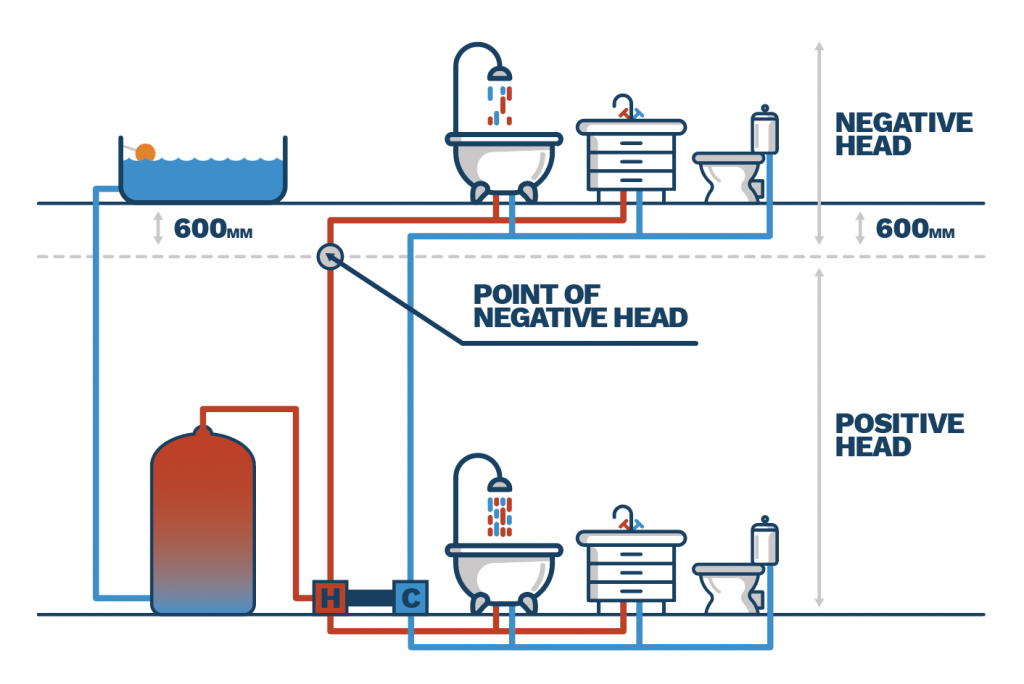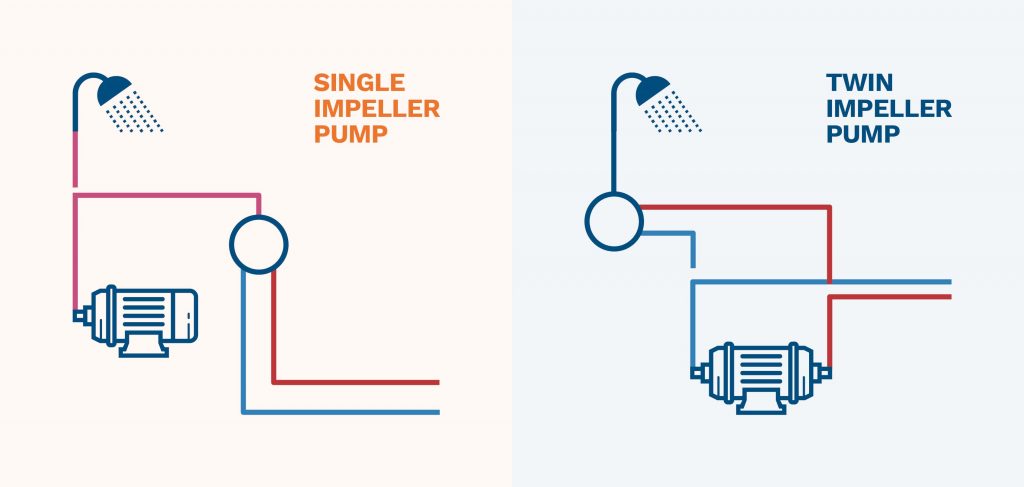Do I Need a Positive or Negative Shower Pump? (Expert Guide)
If your shower is not forceful enough due to insufficient water pressure, then you may be considering installing a shower pump to improve the pressure.
But first, before you buy a shower pump, you need to consider whether you need a positive or negative shower pump. So how do you decide which type of shower pump you need?
Well, it will all depend on where your water tank is located in your house. Although this may sound complicated, it’s pretty straightforward after you learn the difference between positive head and negative head systems.
This blog will cover the following:
What is a positive head system?
What is a negative head system?
Do I need a positive or negative head shower pump?
Do I need a single or twin impeller pump?
Do I need a centrifugal or regenerative pump?
What size shower pump do I need?
What are the best positive and negative head shower pumps?
Introduction
If your shower is not forceful enough due to insufficient water pressure, then you may be considering installing a shower pump to improve the pressure.
But first, before you buy a shower pump, you need to consider whether you need a positive or negative shower pump.
So how do you decide which type of shower pump you need?
Well, it will all depend on where your water tank is located in your house.
Although this may sound complicated, it’s pretty straightforward after you learn the difference between positive head and negative head systems.
What is a positive head system?
The most common heating system used in the UK is a gravity fed system.
This system normally features a cold water tank in the loft and a hot water cylinder tank in an airing cupboard.
This is called a positive head system because the cold water tank is positioned 600mm higher than the shower, so water flows downwards via gravity.
Key learning: A positive pump needs a flow rate of at least 0.6 litres a minute and relies on gravity to start the impellers to pump hot and cold water.
What is a negative head system?
However, if the distance between the cold water tank and the shower head is no more than 600mm this is called a negative head system.
In a negative head system, you will need a negative head shower pump. These pumps
incorporate a flow switch enabling them to start automatically when water begins to flow.
Key learning: A negative pump works by drawing water from the tank to the shower and is the best choice for when the shower head is at the same level or higher than the water tank. For example, this would be the ideal pump to use when the shower is located in a loft conversion.
Do I need a positive or negative head shower pump?
And what does all that mean?
Well, to make a decision between a positive and negative shower pump, all you need to do is measure the distance between your cold water tank in the loft and the shower in your bathroom.
Take a look at the graphic below.
As you can see, there are two bathrooms on different levels.
The bathroom on the top level needs a negative head pump as the water has less than 600mm to travel between the water tank and the shower head.
The bathroom on the bottom level needs a positive head pump as the water has more than 600mm to travel between the water tank and the shower head.
If the shower is more than 600mm, about two rulers, below the cold water tank, then you need a positive head shower pump.
If the shower is less than 600mm below the cold water tank, then you need a negative head shower pump.
What else do you need to consider?
Do I need a single or twin impeller pump?
A single impeller shower pump is designed to pump only one type of water. This is usually only used in a water system where one of either the hot or cold water is suffering from low water pressure.
A twin impeller shower pump is designed to increase the pressure of both hot and cold water supplies. This is to ensure that both supplies are boosted to the same level. Twin impeller pumps are more common than single impeller pumps and generally lead to powerful showering.
Do I need a centrifugal or regenerative pump?
A regenerative pump is the cheaper of the two pump types. This is because the parts are usually a lower quality and the pump is easier to install on combi boiler systems. If you’re not too concerned about noise or performance, then a regenerative shower pump is a good option.
A centrifugal pump is made of higher quality components. The higher quality parts will help to reduce noise and they will also generally guarantee a better lifespan for the pump.
Genuinely, the decision is up to you. There are pros and cons to each pump type and it really does often come down to price.
What size shower pump do I need?
The pressure requirements of your home will determine the size of pump that you need.
Consider:
- How much pressure is needed to drive water to the taps and showers?
- How many water units will be in use at one time?
- Do I have more than one shower?
- How big is my home?
Think carefully about the questions above before purchasing a shower pump. It may seem like a good idea to purchase a cheaper, low-pressure shower pump, but if you have a large family, then it may fail to increase the water pressure in your shower.
Saying that, we have a few general rules that should help you make a purchase decision.
A small flat
If you’re living in a small flat, apartment or house as a bachelor/bachelorette or with one partner, then you will need to purchase a pump with 1.5 to 2.0 bars worth of pressure.
Small family (2 Bedroom House)
For a young family in a small, 2 bedroom house, we suggest purchasing something with around 2.0 to 3.0 bars of pressure.
A family of four (3 Bedroom House)
If you have a family of four people plus, then we suggest purchasing a pump with about 3.0 bars of pressure.
Multiple showers
If you have multiple showers and taps in use at one time, then we suggest purchasing a pump with over 3.0 bars of pressure. Something like a 3.6 bar should provide enough power.
What are the best positive and negative head shower pumps?
If you’re buying a shower pump for your own home, then you can’t be blamed for wanting the best possible shower pump installed. A shower is probably the first thing you do in the morning, so you want it to be powerful and also quiet each morning. While there are plenty of cheap shower pumps on the market, each of the three pumps listed below are the very best shower pumps available on the market. They can also be purchased in both positive and negative head versions.
Stuart Turner Monsoon
If you’re looking for a shower pump that will allow the family to sleep while you shower, then the Stuart Turner Monsoon range should definitely be on your radar. Featuring a classy brass body, the Monsoon is designed to minimise voltage (saving you money) and is fitted with anti-vibration feet to help you keep the noise down. A premium market pump option for those looking for a remarkably quiet pump.
Salamander RP range
Salamander, as a brand, has a great reputation for producing quiet and powerful pumps. They’ve achieved this reputation by investing heavily into the now patented noise vibration reduction technology (NVR). This technology involves using innovative new materials to build their pumps and also fitting all their pumps with noise reducing feet. The RP range is the premium Salamander product available on the market as it matches pure power with less noise. Search
Grundfos Amazon
Grundfos pumps are known and trusted across the world for their performance and reliability. Often the go-to choice for contractors and plumbers, the Amazon range by Grundfos uses both low noise motors and anti-vibration feet to deliver minimal noise output. You simply can’t go wrong with the Grundfos Amazon range, as they make a quiet pump both powerful and affordable.
Free Advice
If you’re struggling for advice, ring our dedicated pump experts for free advice on: 0800 112 3134 or 0333 577 3134.
We’re open Monday to Friday 07:00 - 17:30 and Saturday 08:30 - 12:30.



